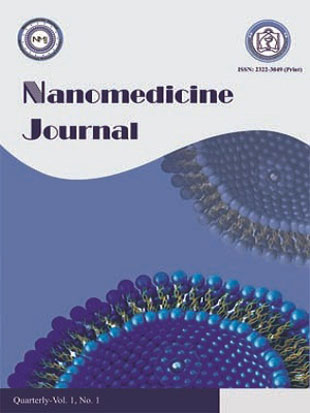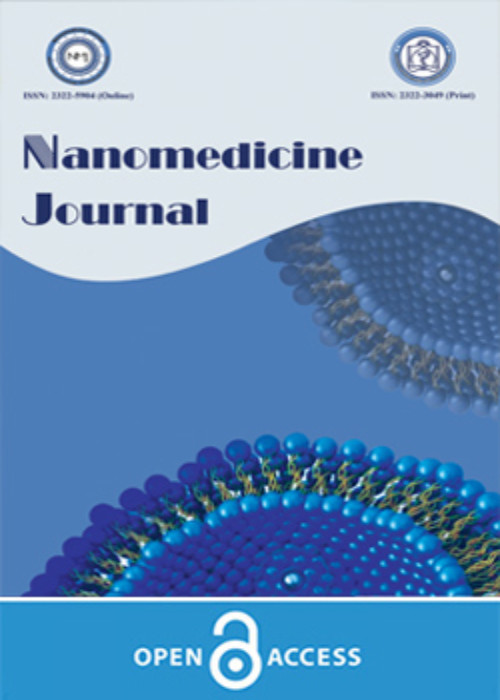فهرست مطالب

Nanomedicine Journal
Volume:1 Issue: 4, Summer 2014
- تاریخ انتشار: 1393/02/24
- تعداد عناوین: 9
-
-
Pages 211-219Objective(s)The current systematic study has reviewed the therapeutic potential of gold nanoparticles as nano radiosensitizers for cancer radiation therapy.Materials And MethodsThis study was done to review nano radiosensitizers. PubMed, Ovid Medline, Science Direct, SCOPUS, ISI web of knowledge, Springer databases were searched from 2000 to September 2013 to identify appropriate studies. Any study that assessed nanoparticles, candidate of radio enhancement at radiotherapy on animals or cell lines was included by two independent reviewers.ResultsGold nanoparticles can enhance radiosenstivity of tumor cells. This effect is shown in vivo and in vitro, at kilovoltage or megavoltage energies, in 15 reviewed studies. Emphasis of studies was on gold nanoparticles. Radiosensitization of nanoparticles depend on nanoparticles’ size, type, concentration, intracellular localization, used irradiation energy and tested cell line.ConclusionStudy outcomes have showed that gold nanoparticles have been beneficial at cancer radiation therapy.Keywords: Gold nanoparticles, Radio sensitizer, Radiation therapy, Systematic review
-
Pages 229-237Objective(s)Biosynthesis of gold nanoparticles (NGPs) is environmentally safer than chemical and physical procedures. This method requires no use of toxic solvents and synthesis of dangerous products and is environmentally safe. In this study, we report the biosynthesis of NGPs using Streptomyces djakartensis isolate B-5.Materials And MethodsNGPs were biosynthesized by reducing aqueous gold chloride solution via a Streptomyces isolate without the need for any additive for protecting nanoparticles from aggregation. We characterized the responsible Streptomycete; its genome DNA was isolated, purified and 16S rRNA was amplified by PCR. The amplified isolate was sequenced; using the BLAST search tool from NCBI, the microorganism was identified to species level.ResultsTreating chloroauric acid solutions with this bacterium resulted in reduction of gold ions and formation of stable NGPs. TEM and SEM electro micrographs of NGPs indicated size range from 2- 25 nm with average of 9.09 nm produced intracellular by the bacterium. SEM electro micrographs revealed morphology of spores and mycelia. The amplified PCR fragment of 16S rRNA gene was cloned and sequenced from both sides; it consisted of 741 nucleotides. According to NCBI GenBank, the bacterium had 97.1% homology with Streptomyces djakartensis strain RT-49. The GenBank accession number for partial 16S rRNA gene was recorded as JX162550.ConclusionOptimized application of such findings may create applications of Streptomycetes for use as bio-factories in eco-friendly production of NGPs to serve in demanding industries and related biomedical areas. Research in this area should also focus on the unlocking the full mechanism of NGPs biosynthesis by Streptomycetes.Keywords: Bio, factory, Green synthesis, Nanogold, Biosynthesis, rRNA, Streptomyces
-
Pages 238-247Objective(s)This paper describes synthesizing of magnetic nanocomposite with co-precipitation method.Materials And MethodsMagnetic ZnxFe3-xO4 nanoparticles with 0-14% zinc doping (x=0, 0.025, 0.05, 0.075, 0.1 and 0.125) were successfully synthesized by co-precipitation method. The prepared zinc-doped Fe 3O4 nanoparticles were characterized by X-ray diffraction (XRD), transmission electron microscopy (TEM), Fourier transform infrared spectroscopy (FTIR), vibrating sample magnetometer (VSM) and UV-Vis spectroscopy.Resultsresults obtained from X-ray diffraction pattern have revealed the formation of single phase nanoparticles with cubic inverse spinal structures which size varies from 11.13 to 12.81 nm. The prepared nanoparticles have also possessed superparamagnetic properties at room temperature and high level of saturation magnetization with the maximum level of 74.60 emu/g for x=0.075. Ms changing in pure magnetite nanoparticles after impurities addition were explained based on two factors of “particles size” and “exchange interactions”. Optical studies results revealed that band gaps in all Zn-doped NPs are higher than pure Fe 3O4. As doping percent increases, band gap value decreases from 1.26 eV to 0.43 eV.Conclusionthese magnetic nanocomposite structures since having superparamagnetic property offer a high potential for biosensing and biomedical application.Keywords: Biomedical application, Fe3O4 nanoparticles, Saturation magnetization, Superparamagnetism, Zn, doping
-
Pages 267-275Objective(s)The enzymatic activity of fungi has recently inspired the scientists with re-explore the fungi as potential biofactories rather than the causing agents of humans and plants infections. In very recent years, fungi are considered as worthy, applicable and available candidates for synthesis of smaller gold, silver and other nano-sized particles.Materials And MethodsA standard strain of Aspergillus parasiticus was grown on a liquid medium containing mineral salt. The cell-free filtrate of the culture was then obtained and subjected to synthesize SNPs while expose with 1mM of AgNO 3. Further characterization of synthesized SNPs was performed afterward. In addition, antifungal activity of synthesized SNPs was evaluated against a standard strain of Candida albicans. The reduction of Ag+ ions to metal nanoparticles was investigated virtually by tracing the color of the solution which turned into reddish-brown after 72h.ResultsThe UV-vis spectra demonstrated a broad peak centering at 400nm which corresponds to the particle size much less than 70nm. The results of TEM demonstrated that the particles were formed fairly uniform, spherical, and small in size with almost 90% in 5-30nm range. The zeta potential of silver nanoparticles was negative and equal to -15.0 which meets the quality and suggested that there was not much aggression. Silver nanoparticles synthesized by A. parasiticus showed antifungal activity against yeast strain tested an d exhibited MIC value of 4 μg/mL.ConclusionThe filamentous fungus, A. parasiticus has successfully demonstrated potential for extra cellular synthesis of fairly monodispersed, tiny silver nanoparticles.Keywords: Aspergillus parasiticus, Biosynthesise, Extracellular, Silver nanoparticles
-
Pages 285-291Objective(s)Nanosilver is one of the most widely used nanomaterials due to its strong antimicrobial activity. Thus, because of increasing potential for exposure of human to nanosilver, there is an increasing concern about possible side effects of these nanoparticles. In this study, we tested the potential dermal toxicity of nanosilver bandage on serum chemical biomarkers in mice.Materials And MethodsIn this study, 20 male BALB/c mice were randomly allocated into the treatment and control groups (n=10). After general anesthesia and shaving the back of all animals in near the vertebral column, in the nanosilver group, a volume of 50μl of 10 μg/ml of nanosilver solution (40 nm), and in the control group the same amount of distilled water was added to the sterile bandage of mice, then the bandages were fixed on the skin surface with cloth glue. After 3 and 7 days, the bandages were opened and serum levels of blood urea nitrogen (BUN), creatinine (Cr), alanine aminotransferase (ALT) and aspartate aminotransferase (AST) were measured by using standard kits for two groups of mice.ResultsIn treatment group, a significant increase in ALT, AST and BUN levels were observed compared with control group during experiment periods (p<0.05), but there wasn’t a significant increase in Cr level in treatment group during experiment periods (p>0.05).ConclusionThe present results indicated that the dermal absorption of 10 μg/ml nanosilver (40 nm) can lead to hepatotoxicity and renal toxicity in mice.Keywords: Dermal toxicity, Hepatic biomarkers, Nanosilver, Renal function parameters


